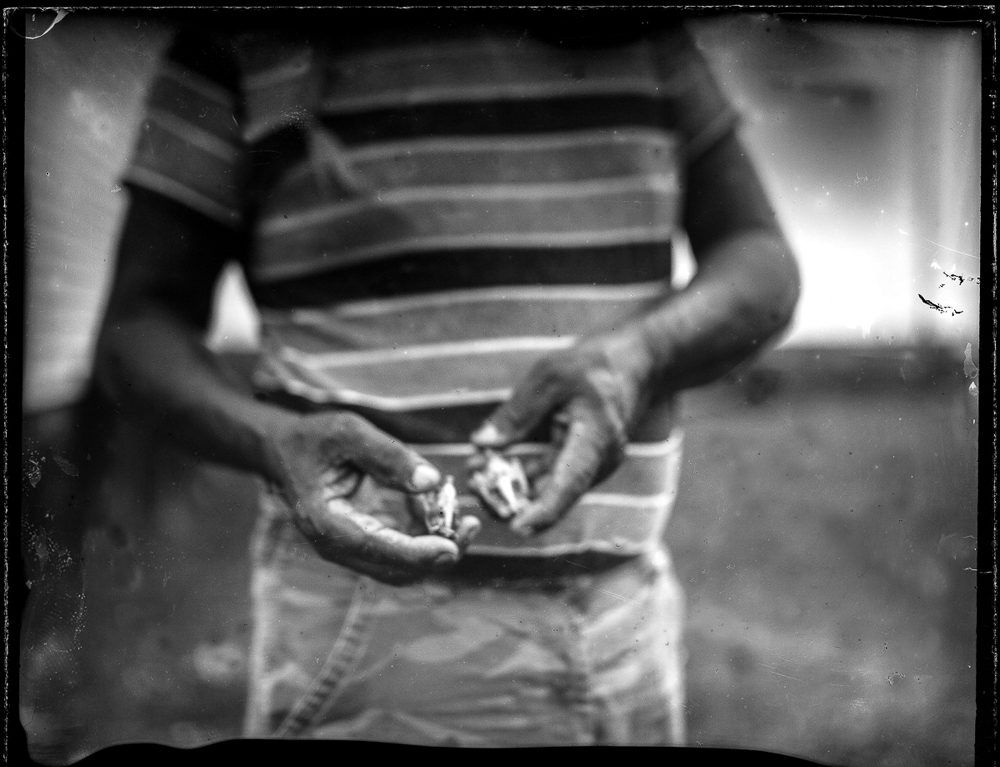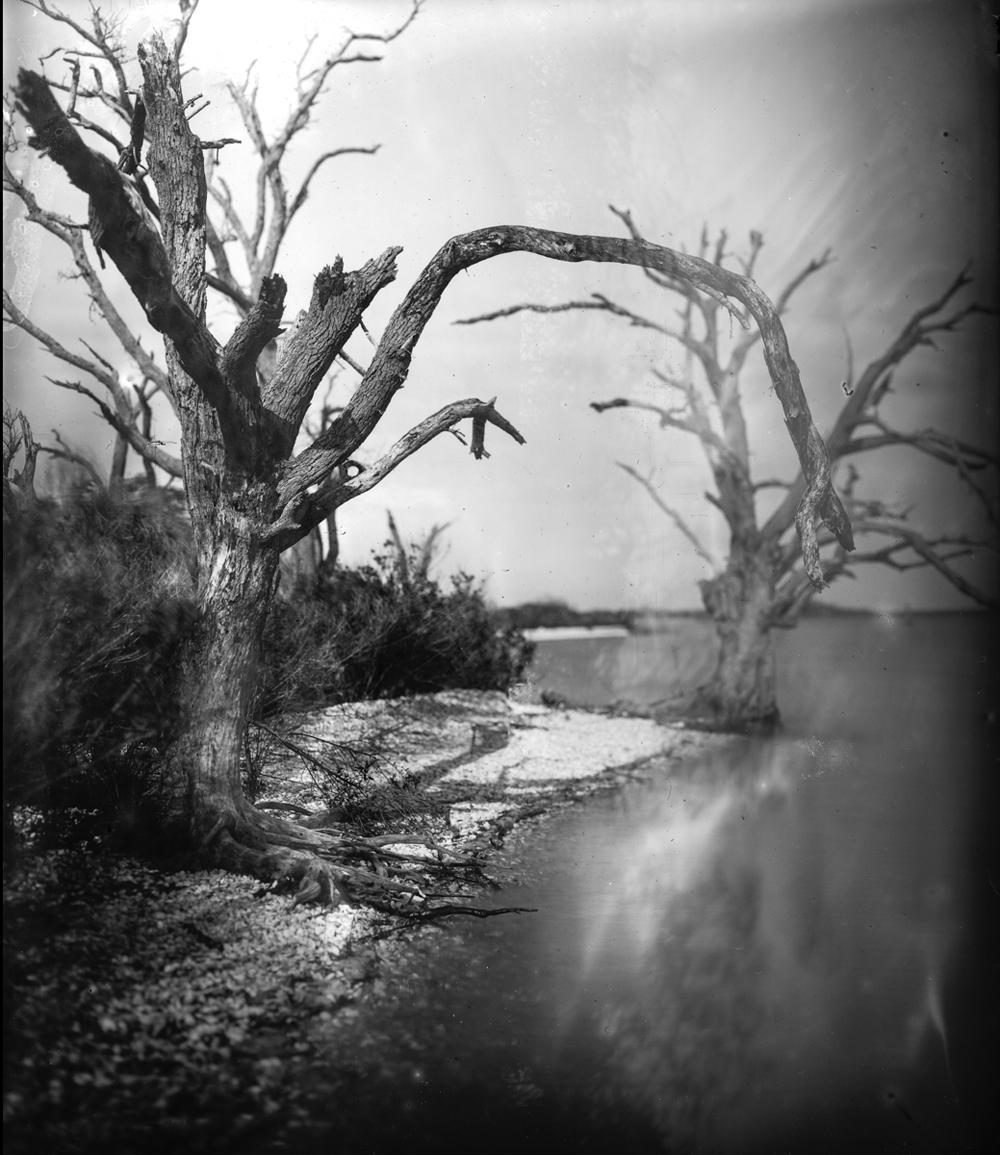Take it Slow: The Photography of Cate Colvin Sampson
Jacob Kiernan heads south to visit Cate Colvin Sampson’s studio on Bayou des Oies to hear about her photographs, which are currently on view at the New Orleans Photo Alliance.

Cate Colvin Sampson, Ray Sees Christ in a Catfish, 2015. Pigment print from handmade gelatin dry plate glass negative. Courtesy the artist.
Traveling south of New Orleans can feel like a journey back in time. Buildings seem to shrink and the horizon widens as I drive towards Barataria. Waterways, both natural and manmade, marble the landscape—part of the elaborate levee system for which Louisiana is so well known. Near the end of Jean Lafitte Boulevard, in a house lifted on story-high stilts, photographer Cate Colvin Sampson lives and works.
Sampson’s yard sits flush with the Bayou des Oies, where she has two small boats: a half-built houseboat and a Lafitte skiff, able to measure the depth of nearby bayous and canals long before the introduction of digital probing. “At the root of being creative,” Sampson says to me, “is the unknown.” Sailing out past the reach of roads and the safety of levees, she explores, camera in keel, the sandy cheniers and coastal swamp.
From the house, Sampson takes me into her darkroom, which smells of ammonia fumes and fermenting eggs. A string of red lights reaches across the space, illuminating patched walls and a sign that reads “Le faire avec un bon coeur.” Enlargers, a timer, a drying rack, carafes of fixer and developer, and salinized water samples from various points along the canal line the wall. The sound of a motorboat skipping across the current—not 75 feet away—reminds us of the precariousness of the fragile prints and the danger the water poses to the equipment housed within her studio.
For the past few years, Sampson has used historical photographic processes to document the disappearing fishing communities along the coast of Louisiana. Sampson explains her process to me. Invented in the 1870s by Richard Leach Maddox, gelatin dry plates revolutionized photography, enabling photographers to leave behind their portable darkrooms. Relieved of the cumbersome process of on-site developing, photographers were able capture more diverse settings and subject matter. Like a century of photographers before her, Sampson packs her homemade dry plates and large-format camera—its viewfinder stained with forehead grease and with bellows she rebuilt herself—into her boat to investigate the unknown and out-of-sight.
Sampson also uses photographic printing to look back at the genealogy of the medium from the perspective of its current turn toward popularization and rapid dissemination. Albumen printing, one of the techniques she uses, is a bewitching process that involves separating egg whites from the yolks, mixing them with chloride, allowing them to “ripen,” and then floating paper atop the concoction. That paper is in turn cured, dried, and treated with silver nitrate to make it sensitive to UV light, a method that seems more like sorcery than science. Sampson is now the keeper of knowledge on the brink of extinction. But for me, hearing about the process and seeing its results provokes a primitive excitement, like discovering a book that’s been unopened for generations.

Cate Colvin Sampson, Ghost Oak, 2016. Pigment print from handmade gelatin dry plate glass negative. Courtesy the artist.
After returning home from Nashville, where she helped start a community darkroom after college, Sampson, a native of Louisiana, realized how restricted entry to the coastline was. Levee walls, industrial infrastructure, and even public parks limit access to the waterline. Without access and oversight, erosion and industrial pollution have proliferated. At first by canoe, and later by skiff, Sampson began to investigate. She discovered the damage inflicted upon local fishermen, who now struggle to subsist on sales of their daily yield. Her photographs offer a visual representation of these abused ecologies and fatigued communities.
Sampson has found that the very slowness of her process—of using a large-format camera with gelatin dry plates—has helped her to engage these communities. Unlike some documentary photographers who enter a foreign environment and leave quickly, Sampson actually lives along the coast and has grown to share many of the concerns of her subjects. Only able to take four to six photographs per trip, each of which takes ample time to frame on her large-format camera, Sampson has internalized the importance of representing her subjects, whom she gets to know well through her process, with care and respect. In turn, her photographs lend a voice to those whose homes and livelihoods have been and are being destroyed.
In the darkroom, I flip through some of Sampson’s photographs, now on view in “All the Place You’ve Got,” her recently opened show at the New Orleans Photo Alliance. They depict ghostly oak trees, shriveled and bare from the advance of salt water onto their shores; Louisiana Native Americans, the Atakapa-Ishak people, relocated and still unrecognized by the federal government; a rough-handed fisherman who imagines the body of Christ in the underside of a catfish skull. These vanishing cultures share something essential with Sampson’s outmoded process: They are struggling to keep their last chapter from closing.
Before I head back to the city, Sampson takes me to a small, above-ground cemetery in her backyard, which she calls “the garden.” A dozen or so plaster-white tombs, dating back to the mid-eighteenth century, remind me of the Victorian photography of the dead—mementos that are unfashionably cryptic compared to contemporary sentiment. She directs me to stand in front of one of the pale tombs and sets up her unwieldy camera. She tells me to hold still, flips the lens open and begins to count: one Mississippi, two Mississippi, three Mississippi, four. The shutter snaps closed while water laps in the background.
Editor's Note
Cate Colvin Sampson’s “All the Place You’ve Got” is on view through July 31, 2016, at the New Orleans Photo Alliance (1111 St. Mary Street).



